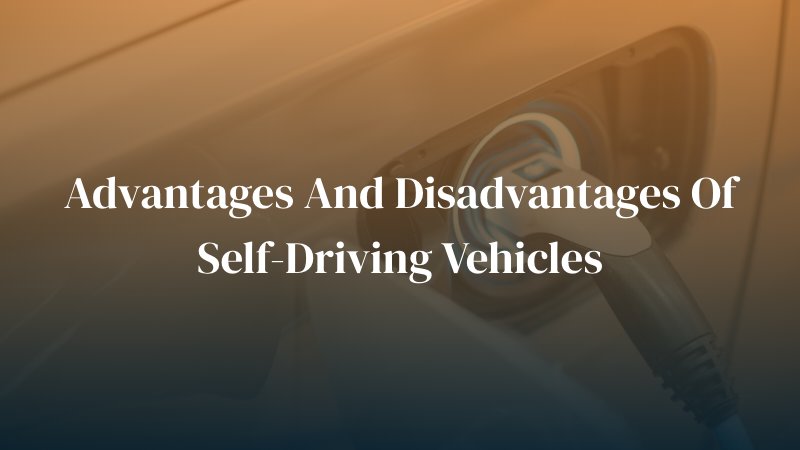Updated May 29, 2024
Many may think self-driving cars are still a long way away from reality. The truth is, the evolution of automated driving systems is very much underway today. In fact, most modern vehicles already contain some degree of automation. As technology develops, vehicles will increasingly become more and more automated. Projections for the global autonomous car market are expected to be at $60 billion by 2030. Since we are wading into somewhat uncharted territories, experts have been weighing the pros and cons of self-driving vehicles. For instance, though touting convenience and safety, the much-contested Tesla AutoPilot pros and cons debate raises issues of security, regulation, and liability. Read on as our Las Vegas car accident attorneys explore further some of the most commonly raised pros and cons for self-driving cars.

Pros of Self-Driving Cars
1. Reduction of accident rates
Of the 37,133 vehicle fatalities in 2017, 94% of the crashes were due to human error. Computers based on sophisticated systems and algorithms will essentially eliminate costly human error. Major causes of accidents, including drunk or distracted driving, will not be factors with self-driving cars. It’s estimated self-driving cars can reduce accidents by up to 90%.
2. Societal cost-savings
One of the major factors when weighing the pros and cons of automated cars is the cost to society. Reports have shown that autonomous vehicles can help save society approximately $800 billion each year. The reduction in car crash-related costs, reduced strain on the healthcare system, more efficient transportation, better fuel savings, and more can all contribute to the overall societal cost-savings.
3. Traffic efficiency
One of the major benefits of self-driving cars is their ability to communicate with each other. With this ability to communicate in real-time, cars would be able to travel efficiently at optimized distances from each other. They’d also determine the best route for you to take, as to eliminate bumper-to-bumper traffic jams.
4. Better access and mode of transportation
For those who cannot or choose not to drive, self-driving cars could be a safe and reliable mode of transportation. Those with a disability or the elderly would be able to get into a self-driving car without putting others at risk. Cities with limited public transit coverage would also benefit from self-driving cars. Self-driving cars can easily reach areas where infrastructure is lacking.
5. Environmentally friendly
Another significant factor in the self-driving cars pros and cons debate is the environment. Autonomous cars will likely be electric rather than utilizing internal-combustion engines. Furthermore, the consistent speeds self-driving cars will be traveling at will reduce constant braking and accelerating. These factors will all contribute to reducing emissions and becoming more environmentally sustainable.
Cons of Self-Driving Cars
1. Security issues
One of the potential cons about self-driving cars is the possibility of hacking. To have automated cars talk and coordinate with each other, they would need to share the same network protocol. If a large number of cars share the same network, however, they would be susceptible to a hack. Even a small hack could wreak significant damage on busy roads by causing collisions and gridlock traffic.
2. Job losses
Those who depend on driving to make a living may find their career obsolete with the introduction of self-driving cars. Those in the trucking industry, bus drivers, taxi drivers, will all need to find new employment. Fast food delivery and Uber drivers would also find themselves replaced by automated cars.
3. Too Expensive
While self-driving cars may produce significant societal cost-savings in the long-term, the initial cost of automated vehicles may be astronomical. Some experts estimate it could cost an additional $250,000 per vehicle to own a fully autonomous vehicle. Of course, as new technology matures, cost should come down. In the early stages, however, the barrier to entry may be too high for the general population.
4. Moral Machine dilemma
Another one of the disadvantages to self-driving cars is their lack of ability to make judgments between multiple unfavorable outcomes. For example, what if a self-driving car had to face a situation with only two possible options:
- Veering to the left and striking a pedestrian
or
- Veering to the right and hitting a tree, potentially injuring passengers inside your vehicle
Since both options are undesirable, which option would the autonomous car choose? The Moral Machine, developed by a group at MIT, is seeking to address this issue by collecting data on real-life people’s decisions. However, the data collected shows broad differences amongst different people groups, making it difficult to program any definitive answer for autonomous cars.
5. Machine error
Machine error must be taken into consideration when examining the pros and cons of driverless cars. While most agree self-driving cars will likely prevent more accidents from happening, it does not completely eliminate the risk of accidents caused by machine error. Furthermore, if the software or any part of the vehicle fails, an autonomous vehicle could put the driver in more danger than if the driver was to personally take control of the vehicle.
Self Driving Car Accident Statistics
With the advent of self-driving cars, accident dynamics are beginning to shift, making it essential to examine the statistics and implications of these autonomous vehicles on road safety.
Driverless car accidents while testing the autonomous technology at low speeds: Autonomous vehicle accidents during low-speed trials account for 16.6% of incidents involving these vehicles.
This helps us to assess the risks and reliability associated with autonomous cars because it reveals that collisions can take place even when these vehicles are operating at reduced speeds. Such findings underscore the importance of continued innovation and enhancement within this technology to maximize safety in unmanned automobiles.
Safety-Related Disengagements: For every million miles of travel, self-driving vehicles report a mean rate of roughly 1.18 occurrences where safety mechanisms must be engaged. This figure confirms the reliability of autonomous vehicles and suggests that incidents requiring safety intervention are infrequent overall.
This data provides comfort to individuals apprehensive about the dependability of driverless cars, indicating a level of safety they may have been questioning.
Less Accidents Per Miles Driven: Crashes involving self-driving cars are logged at a slightly reduced frequency than traditional vehicles, registering 4.7 incidents per million miles traveled. This number emphasizes the promise of autonomous technology in improving overall traffic safety.
Comparing self-driving cars to regular ones, which usually have more crashes, shows us that self-driving cars might be safer or at least have the potential to become safer in the future. This is primarily because they use advanced sensors, machine learning algorithms, and real-time data processing to help avoid the mistakes humans make when they get distracted or tired.
Software Updates to Increase Safety: On average, self-driving cars receive between 10 to 20 software updates each year, significantly enhancing their safety features. These updates are crucial for refining the algorithms that control vehicle behaviors in varying situations, improving the detection of obstacles and enhancing decision-making processes under diverse driving conditions.
Software updates also address identified vulnerabilities and adapt to newly discovered road safety challenges, ensuring that autonomous vehicles stay at the forefront of technological advancements. This continuous improvement allows for the incorporation of the latest research findings and real-world feedback, making self-driving cars increasingly safer and more reliable on the road.
Self-driving Cars Could Save Up To 21,700 lives: Estimates suggesting that self-driving cars could save approximately 21,700 lives and prevent up to 4.22 million accidents annually by the year 2050. This significant reduction in accidents and fatalities is largely attributed to the elimination of human error, which is currently the leading cause of most road accidents.
Autonomous vehicles, with their advanced sensors, artificial intelligence, and machine learning capabilities, are designed to react more accurately and faster than humans in a wide range of driving conditions.
Self-driving technology could make our roads safer by reducing human errors like getting distracted, being tired, or driving under the influence and making bad decisions while driving. This change has the potential to protect everyone using the roads, both people in cars and those on foot, which could significantly improve safety for everyone
Valiente Mott
As you can see from this analysis of self-driving cars, plenty of debate exists on both sides of the table. Self-driving cars may be the way of the future, but there are still some significant roadblocks in the way. Valiente Mott Injury Attorneys is a Las Vegas personal injury firm specializing in representing accident victims. Contact us today to learn more about how we can help you in your case!

